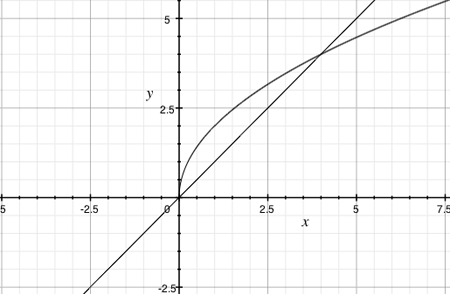| |||
| Math Central | Quandaries & Queries |
|
Question from Lola: find the set of values of constant C for which the line y=x+c intersects the curve y=2 square root x at, at two distinct points |
Hi Lola,
I started by plotting the curve $y = 2 \sqrt{x}$ and then the line with $C=0,$ that is $y = x.$

Clearly $y = 2 \sqrt{x}$ and $y = x$ intersect at $x = 0$ and, from the graph, at some other point also.
The line $y = x + C$ is parallel to $y = x.$ If $C$ is negative $y = x + C$ is below the line $y = x$ and will only intersect the curve once. From the graph, if $C$ is slightly larger than zero the line will intersect the curve twice. Again from the graph it looks like for some value of $C$ the line will be tangent to the curve and intersect the curve exactly once. If $C$ is too large then $y = x + C$ will miss the curve entirely.
To determine where the line $y = x + C$ and the curve $y = 2 \sqrt{x}$ intersect you need to solve
\[2 \sqrt{x} = x + C.\]
I would square both sides and simplify to obtain a quadratic in $x.$ A quadratic equation has two distinct roots if and only if the discriminant is positive. Find the discriminant of your equation and determine for what values of $C$ it is positive.
Does your answer agree with the graphical development I gave above?
Penny
 |
||
| * Registered trade mark of Imperial Oil Limited. Used under license. | ||
Math Central is supported by the University of Regina and the Imperial Oil Foundation.